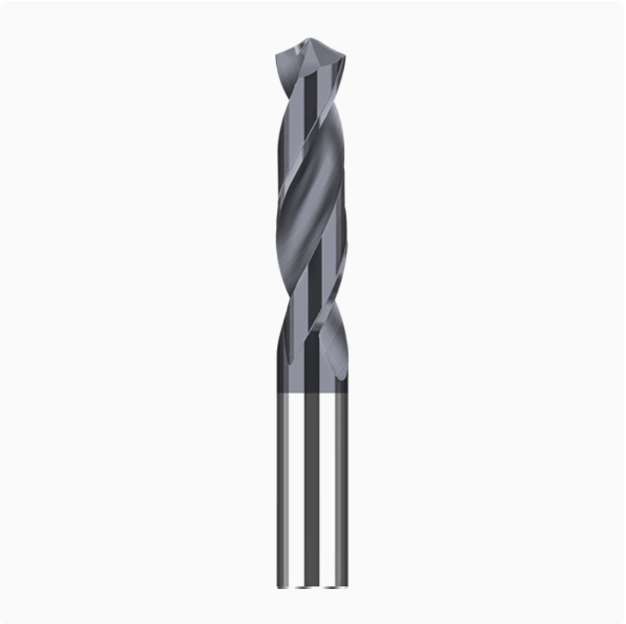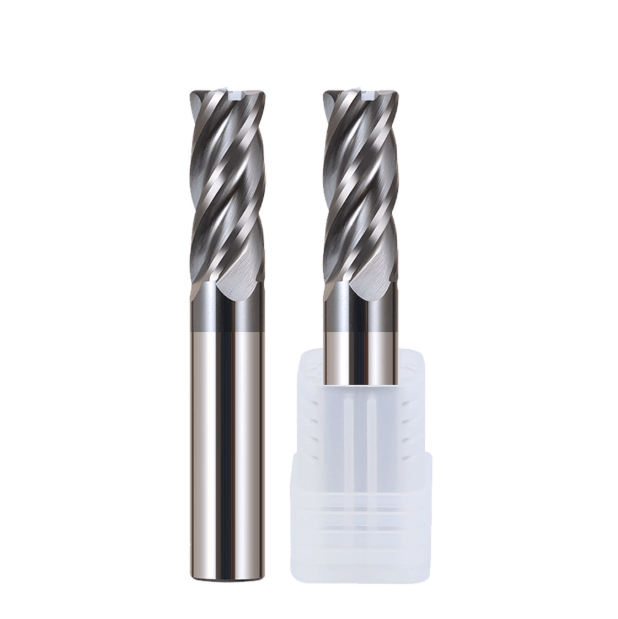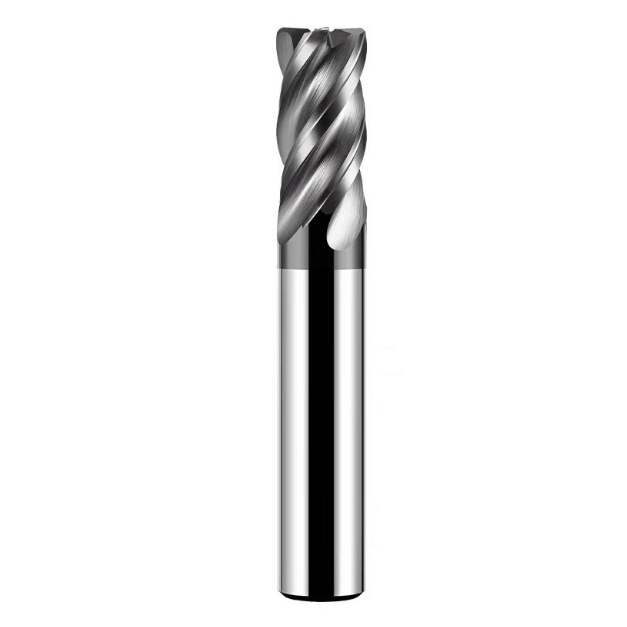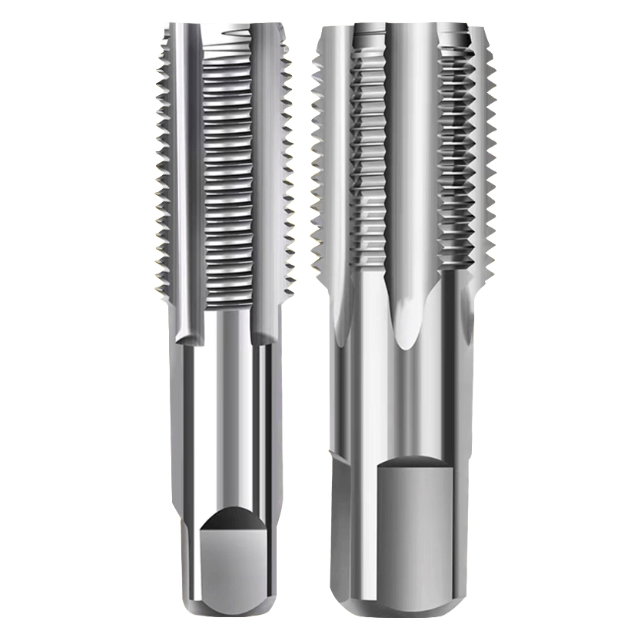Cutting graphite and composite materials places exceptionally high demands on tool wear resistance, cutting edge sharpness, and chip evacuation. Due to the high hardness, strong abrasiveness, and brittleness of these materials, conventional milling cutters often struggle to achieve both efficient machining and superior surface quality. Therefore, specialized end mill cutters for graphite and composite materials are essential for high-precision applications.
Carbide end mill cutters, known for their excellent wear resistance and high-temperature stability, have become the mainstream choice for machining difficult materials such as graphite electrodes and carbon fiber composites. When combined with the high-speed CNC milling end mill cutter process in dry cutting conditions, these tools reduce thermal cracking, prevent built-up edges, and significantly improve surface consistency and dimensional accuracy.
In mold and die making and precision CNC tooling, graphite is commonly used for electrodes or mold cavities, while composite materials are extensively applied in lightweight aerospace and automotive components. These industries often rely on custom end mill cutters with optimized geometries to meet specific requirements for workpiece structures, cutting paths, and material properties.
Whether achieving a high-quality finish on mold electrodes or precision forming high-strength composites, the key lies in matching tool design, materials, and coatings. Selecting the appropriate end mill cutter enhances production efficiency, extends tool life, and ensures consistent, repeatable workpiece quality.
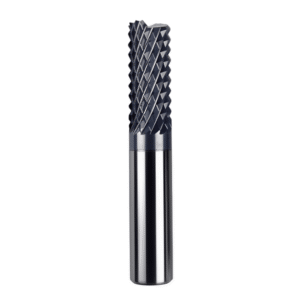
Challenges and Characteristics of Machining Graphite and Composite Materials
Graphite and composite materials offer unique advantages in mold manufacturing, aerospace, and precision components, yet their structural characteristics make them highly challenging to machine. Graphite electrodes and carbon/glass fiber composites (CFRP/GFRP) impose extremely high wear and thermal loads on tools, requiring careful consideration of cutting conditions and tool selection.
Common machining challenges include dust control, delamination between layers, poor thermal conductivity in the cutting zone leading to localized high temperatures, and tool chipping or premature wear. Optimizing tool materials, geometry, and coatings is essential to overcome these issues. Using carbide end mill cutters or diamond-coated end mill cutters designed for highly abrasive materials, combined with high-speed dry cutting or minimum quantity lubrication (MQL), can significantly improve tool life and surface finish.
These challenges push engineers to innovate in tool geometry optimization, chip evacuation, and dust management. Achieving stable and efficient machining requires balancing tool performance with material properties.
Difficulties in Cutting Hard and Brittle Materials
Graphite’s high hardness, low toughness, and brittleness make it prone to dust and microcracks during cutting. Composite materials, composed of resin matrices and carbon or glass fibers, are susceptible to delamination, burr formation, and fiber breakage. Traditional high-speed steel or general-purpose milling cutters quickly lose their edge under high-speed CNC conditions, leading to reduced surface quality.
In high-speed CNC milling, frictional heat from cutting accelerates tool wear. Graphite’s abrasiveness dulls cutting edges, while fiber orientation in composites can exacerbate delamination if tool feed is not optimized. Ultra-fine grain carbide end mill cutters or diamond-coated end mills reduce chipping risk, maintain sharpness, and extend tool life.
Maintaining minimal depth of cut, high spindle speed, and precise toolpath planning is crucial for controlling heat buildup and vibration, improving both process stability and dimensional accuracy.
Special Requirements for Tool Materials, Coatings, and Geometry
Machining graphite and composites demands targeted tool design. Carbide end mill cutters provide high hardness and thermal stability, while CVD diamond or PCD coatings further enhance wear resistance and surface finish.
Tool geometry—including helix angle, rake angle, and cutting edge treatment—directly affects performance. High helix angles improve dust evacuation, sharp edges reduce delamination in composites, and slotted flutes in graphite prevent thermal cracking and dust blockage.
Custom end mill cutters allow optimization of cutting edge shape, coating thickness, and core diameter for complex geometries and high-efficiency machining in precision CNC tooling and mold and die making. By carefully balancing material, coating, and geometry, engineers can significantly improve tool life and maintain consistent surface quality.

High-Performance End Mill Cutters for Graphite Machining
Graphite’s high hardness, brittleness, and strong abrasiveness make it widely used for EDM electrodes, mold cavities, and high-temperature components. However, it is extremely sensitive to tool wear, especially under high-speed CNC milling conditions, where conventional tools can easily chip or blunt. Selecting high-performance end mill cutters specifically designed for graphite is critical to maintain machining efficiency and surface quality.
Carbide end mill cutters and diamond-coated end mills are the most common high-performance options for graphite machining. They preserve a sharp cutting edge and stable geometric accuracy even in extremely dry cutting environments, enabling high-speed machining with minimal wear and excellent surface finish. In mold and die making or precision electrode production, these tools reduce tool change frequency and cost while ensuring repeatable, consistent results.
Comparison of Carbide and Diamond-Coated Tools
In graphite machining, tool wear resistance and cutting stability are key factors in overall machining quality. Carbide end mill cutters provide excellent toughness and consistent performance for medium-speed and finishing operations. CVD diamond-coated or PCD tools maintain sharp edges at higher speeds and extend tool life significantly.
Diamond-coated cutters offer a very low coefficient of friction and superior thermal conductivity, reducing graphite dust accumulation and high-temperature oxidation, which further lowers surface roughness. CVD diamond end mills also maintain dimensional stability within 0.005 mm when machining precision electrodes, making them ideal for finishing mold electrodes or complex cavities.
While diamond-coated tools have a higher upfront cost, their lifespan is typically 5–10 times longer than conventional carbide end mills, providing a strong cost advantage in high-volume, high-precision graphite machining. This makes them preferred choices for engineers in precision mold manufacturing and aerospace electrode production.
High-Speed CNC Milling End Mill Cutter Applications in Dry Cutting
Graphite is usually machined dry to prevent coolant from mixing with dust and forming a conductive layer. High-speed CNC milling end mill cutters are specifically designed for these dry conditions, offering excellent heat and chipping resistance at high spindle speeds.
Tools with ultra-fine carbide substrates and diamond coatings can maintain stable cutting at 20,000–30,000 rpm while minimizing dimensional deviations caused by thermal expansion. Their optimized cutting edge design and high helix angles effectively control dust emission, prevent secondary cutting, and reduce the risk of tool blockage.
Using an efficient dust extraction system alongside optimal cutting parameters further protects machine guideways and spindles from graphite dust, extending machine life. High-speed dry cutting is therefore not only standard practice for graphite electrodes but also a crucial method for improving efficiency in high-precision mold applications.
Key Points for Selecting a Mold and Die Making End Mill Cutter
The machining quality of graphite electrodes directly impacts the final precision and surface finish of EDM molds. Selecting the right mold and die making end mill cutter is essential.
-
Tool type by machining stage: Use coarse-grain carbide or CVD diamond-coated roughing cutters for efficient material removal; employ fine-grain carbide or PCD end mills for finishing to achieve superior surface finish and edge sharpness.
-
Tool geometry compatibility: Small corner radii reduce stress at cavity bottoms, and sharp rake angles improve microstructure cutting quality.
-
Custom end mill cutters: Tailor cutting edges and helix angles to match complex 3D curved electrodes, improving machining efficiency and surface consistency.
-
Machine and clamping system: High-rigidity fixturing and low-runout spindles ensure stable, repeatable machining for every mold electrode.

Tooling Strategies in Composite Materials Machining
Composite materials are widely used in high-end manufacturing, including aerospace, lightweight automotive, medical devices, and sports equipment, due to their high strength-to-weight ratio, corrosion resistance, and dimensional stability. However, their heterogeneous structure poses significant challenges during CNC milling.
Materials such as CFRP and GFRP exhibit non-uniformity, delamination, and high abrasiveness. Fiber layers and the resin matrix can separate under cutting forces and heat, leading to increased tool wear, burr formation, and fiber pullout. A well-planned tooling strategy using optimized precision CNC tooling end mill cutters is essential for stable and efficient machining.
Common Problems with Delamination, Burrs, and Fiber Pullout
Machining defects in composites stem primarily from their anisotropic nature. Differences in strength and modulus between fiber layers and resin matrices can lead to delamination, fiber pullout, and edge burrs when cutting forces exceed material limits.
For CFRP, large tool rake angles may concentrate force on fibers, causing them to pull rather than shear. Small rake angles can generate excessive heat, softening resin and promoting interlaminar delamination. In GFRP, abrasive glass fibers quickly dull the cutting edge, increasing burrs and burns.
Using carbide or PCD end mills for composites with sharp edges, moderate helix angles, and wear-resistant coatings mitigates these problems. A combined “up-cut + down-cut” geometry further balances cutting forces, reducing delamination.
Geometric Optimization Design of Precision CNC Tooling End Mill Cutter
Tool geometry is critical for cutting quality. Key parameters include:
-
Rake angle: Moderately positive to reduce cutting forces and heat while minimizing delamination.
-
Helix angle: Medium-to-high angles improve fiber layer cutting, reducing vibration and burrs.
-
Edge treatment: Micro-chamfering or mirror polishing enhances edge strength and wear resistance.
High-performance precision CNC tooling end mill cutters, often combining diamond coatings with ultra-fine carbide substrates, maintain sharp and stable cutting at high speeds. Optimized geometry improves chip evacuation and surface finish, particularly in carbon fiber aerospace skins or medical devices.
Tool Cooling and Dust Control in High-Speed Cutting
Traditional wet cooling may contaminate composites or cause resin absorption. Engineers prefer dry cutting or MQL:
-
Dry cutting: Ideal for high-speed, high-rigidity environments. Diamond-coated end mills reduce heat and chip accumulation due to low friction.
-
MQL: Creates a thin protective oil film, reducing temperature and improving chip removal.
Dust extraction is also critical. Fine dust from CFRP and GFRP can abrade machine guideways and pose health risks. Efficient vacuum systems, sealed chambers, and filtration maintain clean working conditions and extend both tool and machine life.
By controlling spindle speed, feed rate, and cooling strategies, high-speed CNC milling achieves a balance between tool life, surface quality, and environmental safety.

Customized Advantages of Custom End Mill Cutters in Graphite and Composite Machining
For challenging graphite and composite material machining, custom end mill cutters provide tailored optimization of tool geometry, material, and coating to meet diverse workpiece configurations, machining methods, and surface quality requirements. Compared to standard tools, customized cutters significantly improve CNC machining accuracy, extend tool life, reduce tool change frequency, and lower overall manufacturing costs. For companies focused on high surface finish, dimensional stability, and efficiency, custom tooling solutions are a key strategy in graphite electrode machining and composite component machining.
In high-end industries such as mold and die making and aerospace CNC machining, custom end mills enhance tool-workpiece compatibility, ensuring stable cutting and efficient chip evacuation on complex 3D surfaces, deep cavities, and thin-walled structures. By optimizing tool geometry and selecting appropriate coating systems, such as diamond-coated end mills or PCD-tipped cutters, tool wear and delamination are minimized, enabling consistent, long-term cutting performance.
Customizing Tool Geometry and Cutting Edges Based on Workpiece Structure
Tool geometry is especially critical when machining complex curved or shaped parts in graphite and composite materials. Adjusting the rake angle, helix angle, end cutting edge shape, and edge honing ensures more stable cutting force distribution, reduces vibration, and minimizes surface tearing.
-
Graphite electrodes: High-helix carbide end mills improve chip evacuation and reduce cutting temperatures.
-
CFRP: Multi-flute custom tools minimize fiber breakage and burr formation.
-
High-precision parts: Diamond-coated custom end mills provide superior surface finish and extended tool life.
Application Examples of Customized Tooling in Mold and Aerospace Industries
-
Mold and die making: Graphite electrodes require extremely high surface finish and geometric accuracy. Custom end mills match electrode geometry with tool parameters, allowing high-speed dry machining without dust clogging or thermal damage.
-
Aerospace: When machining CFRP or honeycomb materials, custom end mills reduce delamination, spalling, and heat buildup. Combined with high-speed CNC milling, these tools increase material removal rates while maintaining workpiece structural integrity, making them essential for precision machining of composite airframe components.
From Design to Verification: The Custom End Mill Cutter Development Process
Developing a custom end mill involves a comprehensive engineering process:
-
Requirement analysis: Define material properties, cutting paths, and surface quality goals.
-
CAD/CAM simulation: Predict cutting performance and chip evacuation behavior.
-
Prototype testing: Evaluate tool wear, cutting temperature, and surface finish.
-
Optimization: Refine geometry, coating thickness, and material composition for a final, reliable design.
This process ensures tool reliability, consistent performance, and cost-effective precision machining for complex graphite and composite applications.
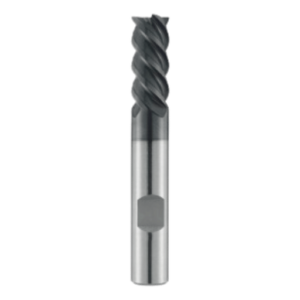
Key Parameters and Practical Techniques for Improving Graphite and Composite Material Machining Efficiency
High-precision graphite and composite material machining efficiency depends not only on tool performance but also on cutting parameters, toolpath planning, and machine stability. Choosing the right carbide end mill cutter or custom end mill cutter, combined with an optimized machining strategy, can significantly improve material removal rates, extend tool life, and maintain consistent, high-quality surfaces.
To maximize efficiency, engineers must carefully consider cutting speed, feed rate, depth of cut, and tool geometry, including helix angle, rake angle, and edge preparation. Proper control of these parameters in high-speed CNC end mill milling also reduces heat buildup, prevents dust accumulation, and avoids tool chipping or workpiece delamination.
Optimization Recommendations for Cutting Speed, Feed Rate, and Depth of Cut
Different graphite and composite materials require specific cutting parameters:
-
Graphite electrodes: High-speed carbide end mills typically run at 20,000–30,000 rpm, with feed rates between 0.02–0.08 mm/tooth to balance fast material removal and minimal thermal stress.
-
CFRP and GFRP: A shallow depth of cut (0.1–0.3 mm) with a high helix angle cutter helps reduce delamination and fiber pullout.
-
Multi-edge end mills: Precision CNC cutters with multiple flutes increase cutting volume per unit time, optimizing efficiency while minimizing vibration.
Tool Life Extension and Wear Monitoring Methods
Maximizing tool life is crucial for production efficiency and cost reduction. Common strategies include:
-
Tool wear monitoring: Track wear through tool diameter measurement, surface roughness inspection, and vibration monitoring.
-
Toolpath optimization: Optimize machining sequence, feed direction, and helical cutting paths to reduce idle time and avoid overload.
-
Coating and edge maintenance: Use wear-resistant PCD or diamond-coated end mills and perform regular micro-chamfering to reduce wear.
These strategies not only extend tool life but also maintain surface consistency and dimensional accuracy, enhancing overall productivity.
Key Operational Points for Maintaining Machining Accuracy and Surface Quality
Even with optimal tool selection and cutting parameters, machine instability and improper procedures can affect results. Critical operational points include:
-
Machine stability: Ensure spindle rigidity and bed vibration damping to prevent surface defects caused by vibration.
-
Clamping accuracy: Use high-rigidity fixtures to prevent workpiece displacement or warping under cutting forces.
-
Vibration suppression: Combine optimized tool geometry, cutting parameters, and damping fixtures to minimize surface roughness and dimensional errors.
-
Dust control: Employ a dust extraction system with a sound cutting strategy to maintain a clean environment, extend tool life, and ensure long-term machining consistency.
By implementing these operational best practices, graphite and composite machining achieves an optimal balance of efficiency, precision, and surface quality.

Selecting the Right End Mill Cutter for Efficient and Precision Machining of Graphite and Composites
Machining graphite and composite materials presents unique challenges due to their high hardness, brittleness, strong abrasiveness, and low thermal conductivity. These characteristics can lead to tool wear, delamination, burr formation, and surface roughness. Selecting the right end mill cutter is essential to achieving stable, high-precision machining while maintaining high efficiency.
High-speed carbide end mills and diamond- or PCD-coated end mills enable effective machining of graphite and composite materials. Under high-speed CNC milling conditions, these tools provide high wear resistance, low friction, and stable cutting edge geometry, reducing the negative impact of heat buildup and dust accumulation on machining quality.
Custom end mill cutters are particularly valuable for machining complex surfaces, mold electrodes, and composite aerospace components. By optimizing tool geometry, cutting edges, and coatings according to the workpiece structure, engineers can achieve:
-
Higher surface finish quality
-
Consistent dimensional accuracy
-
Extended tool life
This customized tooling strategy is especially critical in mold and die manufacturing and the aerospace industry, improving machining efficiency and reducing secondary machining costs.
Optimizing key cutting parameters, monitoring tool wear, and following standardized machining procedures further ensures process control and repeatability. Proper tool selection combined with optimized processes guarantees efficient, stable, and reliable machining of graphite and composite materials.
In summary, by selecting and customizing carbide, diamond-coated, or PCD end mill cutters, and combining coating technologies, high-speed cutting strategies, and precise machining operations, engineers can achieve high-efficiency, precision machining for graphite and composite materials. These strategies provide reliable machining solutions for high-end manufacturing sectors, including mold and die making, precision parts processing, and aerospace applications.




